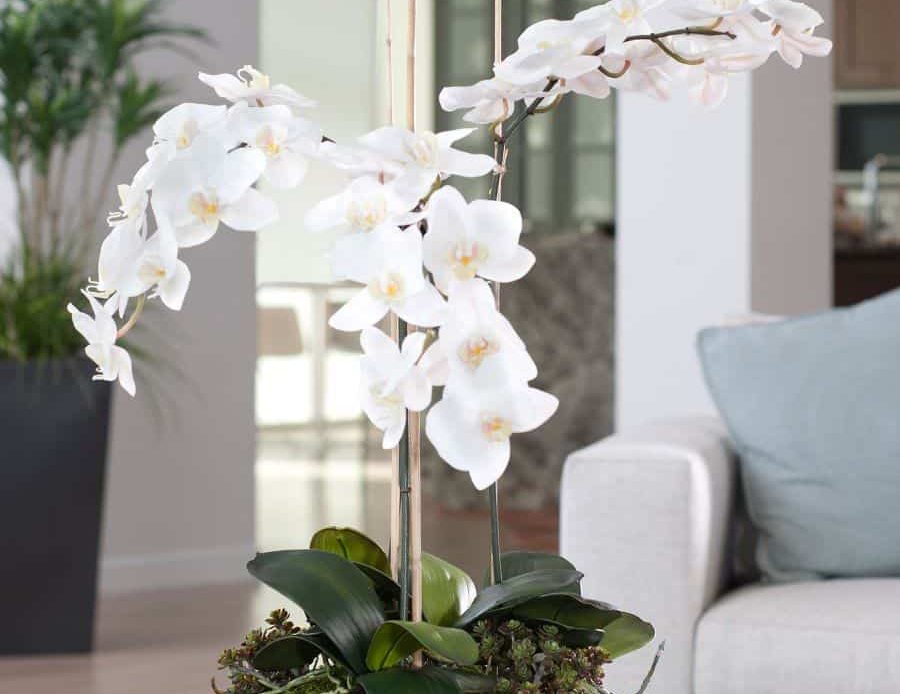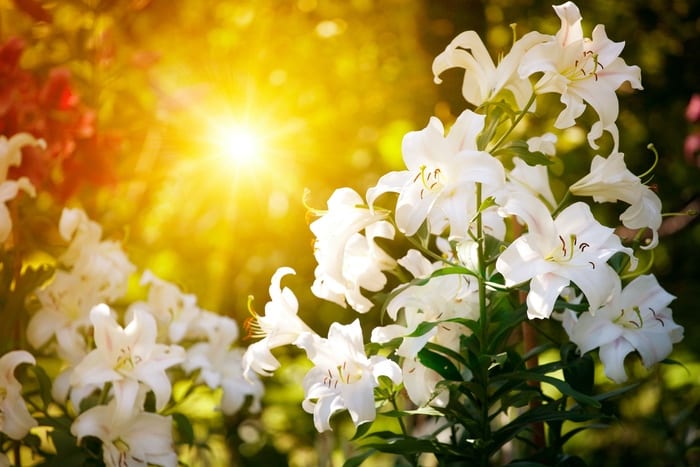The Enduring Allure of the White Flower: Symbolism, Cultivation, and Timeless Beauty

White flowers, with their pristine purity and understated elegance, have captivated humanity for centuries. From the delicate snowdrop pushing through winter’s frost to the majestic gardenia perfuming the summer air, these floral beacons offer a timeless beauty that transcends trends and cultures. More than just ornamental decorations, white flowers are deeply symbolic, representing a spectrum of emotions and ideas, making them a cornerstone of traditions and celebrations worldwide. This article delves into the captivating world of white flowers, exploring their rich symbolism, the nuances of their cultivation, and the enduring allure that continues to make them a beloved choice for gardens, bouquets, and beyond.
The Language of Purity: Symbolism Through the Ages
The color white is universally associated with purity, innocence, and new beginnings. White flowers inherit these connotations, often symbolizing virginity, peace, reverence, and remembrance. Their use in various ceremonies and rituals reflects these powerful associations:
-
Weddings: Perhaps the most prominent association is with weddings. White flowers, particularly roses, lilies, and orchids, are quintessential elements of bridal bouquets and decorations. They symbolize the purity and commitment of the union, signifying a fresh start and a lifelong promise. The choice of specific white flowers can further enhance the message. For instance, white lilies often represent chastity and devotion, while white roses symbolize love and respect.
-
Funerals: White flowers are also commonly used in funeral arrangements, signifying sympathy, respect, and remembrance for the deceased. They offer a message of peace and hope, conveying the sentiment that the departed has moved on to a place of tranquility. White chrysanthemums, lilies, and carnations are frequently chosen for their somber beauty and symbolic representation of grief and respect.
-
Religious Ceremonies: Across various religions, white flowers hold significant spiritual meaning. In Christianity, white lilies are associated with the Virgin Mary and represent purity and grace. In Buddhism, white lotuses symbolize enlightenment and spiritual awakening. These flowers are often used to adorn altars and sacred spaces, representing devotion and reverence.
-
Gardens and Landscapes: Beyond their symbolic use in ceremonies, white flowers play a vital role in gardens and landscapes. They create a sense of tranquility and serenity, providing a visual contrast to the vibrant colors of other blooms. White flowers can also illuminate shady areas, reflecting light and adding depth to the landscape. They offer a calming presence, inviting contemplation and relaxation.


A Palette of White: Exploring Popular White Flower Varieties
The world of white flowers is surprisingly diverse, encompassing a wide range of shapes, sizes, and scents. Here are some of the most popular and captivating varieties:
-
Roses: The quintessential symbol of love and beauty, white roses come in various forms, from delicate tea roses to classic hybrid teas. They represent purity, innocence, and new beginnings, making them a timeless choice for weddings and special occasions.
-
Lilies: Known for their elegant trumpet-shaped blooms and intoxicating fragrance, white lilies symbolize purity, devotion, and remembrance. They are often used in funeral arrangements and religious ceremonies, conveying messages of sympathy and hope.
-
Orchids: Exuding an air of sophistication and grace, white orchids represent purity, elegance, and reverence. They are a popular choice for gifts and decorations, adding a touch of luxury to any setting.
-
Gardenias: Renowned for their creamy white petals and intoxicating fragrance, gardenias symbolize purity, joy, and secret love. They are often used in corsages and bouquets, adding a touch of romance and elegance.
-
Jasmine: With its delicate white flowers and sweet, intoxicating fragrance, jasmine symbolizes love, beauty, and sensuality. It is often used in perfumes and teas, adding a touch of exotic allure.
-
Calla Lilies: These elegant, trumpet-shaped flowers symbolize purity, innocence, and rebirth. They are often used in weddings and funerals, representing new beginnings and remembrance.
-
Hydrangeas: These showy blooms come in a variety of colors, including white. White hydrangeas symbolize understanding, forgiveness, and boastfulness.
-
Snowdrops: These delicate, bell-shaped flowers are among the first to bloom in spring, symbolizing hope, renewal, and purity.
-
Daisies: With their cheerful, sunny faces, white daisies symbolize innocence, purity, and new beginnings.
-
Carnations: While available in many colors, white carnations symbolize purity, innocence, and good luck.

Cultivating the Pristine: Tips for Growing White Flowers
Growing white flowers can be a rewarding experience, allowing you to enjoy their beauty and fragrance in your own garden. Here are some essential tips for cultivating these pristine blooms:
-
Sunlight: Most white flowers require at least six hours of sunlight per day. However, some varieties, such as impatiens and begonias, prefer partial shade.
-
Soil: Well-drained soil is crucial for the healthy growth of white flowers. Amend heavy clay soil with organic matter, such as compost or peat moss, to improve drainage.
-
Watering: Water regularly, especially during dry periods. Avoid overwatering, as this can lead to root rot.
-
Fertilizing: Fertilize regularly with a balanced fertilizer to promote healthy growth and abundant blooms.
-
Pruning: Prune regularly to remove dead or faded flowers and encourage new growth.
-
Pest and Disease Control: Monitor your plants for pests and diseases and take appropriate action to prevent or control them.
-
Consider Your Climate: Choose varieties that are well-suited to your local climate. Research the specific needs of each flower you intend to grow.
-
Grouping for Impact: Plant white flowers in groups to create a dramatic visual impact. A mass of white blooms can be particularly striking against a backdrop of green foliage.
Beyond the Garden: White Flowers in Art, Literature, and Culture
The allure of white flowers extends far beyond gardens and floral arrangements. They have inspired artists, writers, and musicians throughout history, appearing in paintings, poems, and songs. Their symbolic meaning and aesthetic beauty have made them a recurring motif in various cultural expressions.
-
Art: White flowers have been depicted in countless paintings, often symbolizing purity, innocence, and beauty. Artists like Georgia O’Keeffe and Claude Monet have captured the delicate details and ethereal qualities of white flowers in their iconic works.
-
Literature: White flowers often appear in literature as symbols of purity, love, and loss. They can represent the innocence of a young woman, the purity of a love affair, or the grief of mourning.
-
Music: White flowers have inspired numerous songs and musical compositions, often evoking feelings of peace, tranquility, and romance.
The Enduring Appeal
The enduring appeal of white flowers lies in their simplicity and elegance. They offer a timeless beauty that transcends trends and cultures, providing a sense of peace and tranquility in a world that is often chaotic and overwhelming. Whether used in a wedding bouquet, a funeral arrangement, or a garden landscape, white flowers continue to captivate and inspire, reminding us of the beauty and purity that exists in the natural world. Their symbolic weight, combined with their aesthetic appeal, ensures their continued presence in our lives for generations to come.
FAQ about White Flowers
Q: What is the most popular white flower?
A: The rose is arguably the most popular white flower, particularly for weddings and romantic occasions.
Q: Are white flowers only used for funerals?
A: No, white flowers are used for a wide range of occasions, including weddings, religious ceremonies, and as general garden decorations. While they are commonly used in funerals to symbolize sympathy and remembrance, their use is not limited to this event.
Q: What does it mean to dream of white flowers?
A: Dream interpretations vary, but generally, dreaming of white flowers can symbolize purity, innocence, new beginnings, or peace. The specific meaning can depend on the context of the dream and the dreamer’s personal associations with white flowers.
Q: Are white flowers more fragrant than other colors?
A: Not necessarily. Fragrance depends on the specific species of flower, not just the color. However, some popular white flowers, like gardenias and jasmine, are known for their strong and beautiful fragrances.
Q: Can I dye white flowers?
A: Yes, white flowers can be easily dyed using food coloring and water. This is a popular way to create custom floral arrangements.
Q: What are some low-maintenance white flowers to grow in my garden?
A: Some low-maintenance options include white petunias, white alyssum, and white impatiens. These flowers are relatively easy to grow and provide a continuous display of blooms throughout the growing season.
Q: Are there any white flowers that are poisonous?
A: Yes, some white flowers, such as lilies of the valley and daffodils, are poisonous if ingested. It’s important to research the toxicity of any plant before introducing it to your garden, especially if you have children or pets.
Q: How do I keep my white flowers looking pristine?
A: Handle them carefully to avoid bruising, keep them in cool water, and change the water regularly. You can also add floral preservative to the water to extend their lifespan.
Q: Do white flowers attract pollinators?
A: Yes, many white flowers attract pollinators, such as bees and butterflies. Their bright color and sweet fragrance make them attractive to these beneficial insects.
Q: Can I grow white flowers indoors?
A: Yes, some white flowers, such as orchids and peace lilies, can be grown indoors with proper care. Ensure they receive adequate light and humidity.
Conclusion: The Enduring Legacy of White Flowers
The journey through the world of white flowers reveals a tapestry of symbolism, beauty, and cultural significance. From their profound association with purity and remembrance to their versatility in gardens and floral arrangements, white flowers have earned their place as timeless treasures. Their ability to evoke feelings of peace, tranquility, and reverence continues to resonate with people across cultures and generations. Whether admiring a single white rose or a field of blooming daisies, the enduring legacy of white flowers serves as a reminder of the simple yet profound beauty that surrounds us. As we continue to cultivate, appreciate, and celebrate these pristine blooms, we ensure that their timeless allure will continue to inspire and captivate for years to come.
